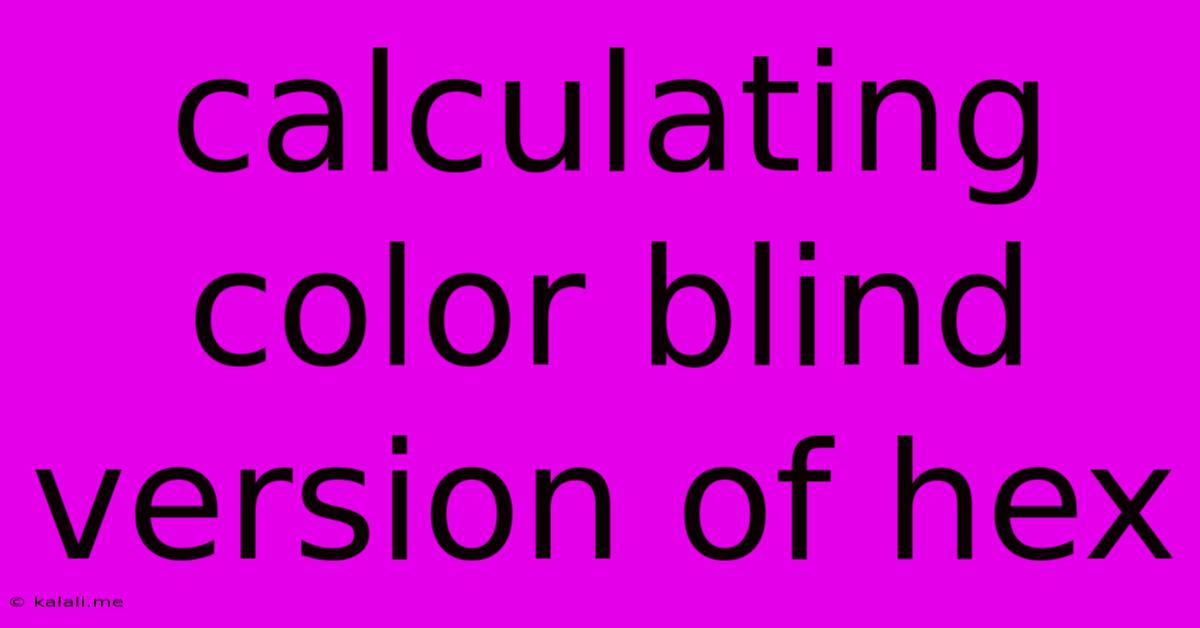Calculating Color Blind Version Of Hex
Kalali
May 23, 2025 · 3 min read

Table of Contents
Calculating Color Blind Versions of Hex Codes: A Guide for Accessible Design
Designing for accessibility is crucial, and a significant aspect of that is accounting for color blindness. Millions of people experience some form of color vision deficiency, making it essential to ensure your designs are understandable and usable for everyone. This article will guide you through the process of calculating color blind versions of your hex codes, helping you create inclusive and accessible digital experiences. We'll explore different types of color blindness and how to effectively adjust your color palettes to ensure readability.
Understanding Color Blindness
Before diving into calculations, understanding the different types of color blindness is crucial. The most common types are:
- Protanopia: Reduced sensitivity to red light.
- Deuteranopia: Reduced sensitivity to green light.
- Tritanopia: Reduced sensitivity to blue light.
These deficiencies affect how individuals perceive colors, leading to potential difficulties distinguishing certain color combinations. For example, someone with protanopia might struggle to differentiate between red and green, while someone with deuteranopia might experience similar challenges. Therefore, simply lightening or darkening colors isn't always sufficient to ensure accessibility.
Methods for Calculating Color Blind Versions
There's no single, universally accepted formula for converting hex codes to account for all types of color blindness. However, several approaches can improve the accessibility of your color schemes. These methods often involve simulating how different types of color blindness affect color perception.
1. Using Online Tools:
Numerous online tools and color simulators are available to help you check the visibility of your color combinations for various types of color blindness. These tools often allow you to input your hex codes and see a simulated view of how the colors would appear to someone with specific color vision deficiencies. This provides a quick and easy way to assess your design's accessibility. Searching for "color blindness simulator" will provide many options.
2. Color Contrast Checkers:
While not directly calculating a "color blind" hex code, tools that check color contrast ratios are essential for accessibility. These tools determine if sufficient contrast exists between foreground and background colors, ensuring readability for individuals with and without color vision deficiencies. A high contrast ratio (WCAG AA requires a minimum of 4.5:1 for normal text) is crucial for overall accessibility. Many online contrast checkers are available.
3. Algorithm-Based Approaches (Advanced):
For developers comfortable with code, algorithms can simulate the effects of color blindness on hex codes. These algorithms manipulate the RGB values of the hex code to mimic the altered perception of a color blind individual. However, implementing these algorithms requires a solid understanding of color science and programming. This approach is more complex but offers a more precise simulation than many online tools.
Best Practices for Accessible Color Palettes
Beyond calculating specific color blind versions, adopting best practices for creating accessible color palettes is crucial:
- Prioritize High Contrast: Ensure sufficient contrast between text and background colors, regardless of color blindness.
- Avoid Relying Solely on Color: Don't use color alone to convey important information. Use additional visual cues like patterns, shapes, or text labels.
- Test with Real Users: If possible, test your designs with individuals who have color blindness to gather direct feedback.
- Use a Diverse Color Palette: Employ a range of colors, but prioritize those that are easily distinguishable even with color vision deficiencies. Blues and yellows often work well.
- Consult Color Blindness Resources: Explore resources and guidelines for accessible design to stay updated on best practices.
Conclusion:
Creating accessible designs requires careful consideration of color blindness. While there isn't a single magic formula, utilizing online tools, color contrast checkers, and implementing best practices for color selection will significantly improve the accessibility and usability of your designs for all users. Remember, accessible design is not just about compliance but about creating inclusive and equitable experiences for everyone.
Latest Posts
Latest Posts
-
How To Write Something Using Quotes Identifying Sarcasm
May 23, 2025
-
Is Oz The Great And Powerful Canon
May 23, 2025
-
Connecting Second Story Deck Post Joint
May 23, 2025
-
Can Number Fields Be Replaced By Function Fields
May 23, 2025
-
Latex Tikz Homology On Double Torus
May 23, 2025
Related Post
Thank you for visiting our website which covers about Calculating Color Blind Version Of Hex . We hope the information provided has been useful to you. Feel free to contact us if you have any questions or need further assistance. See you next time and don't miss to bookmark.